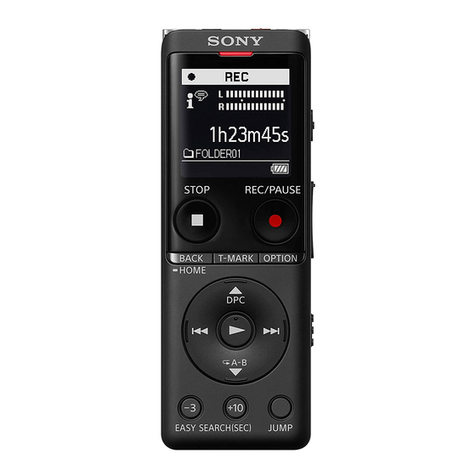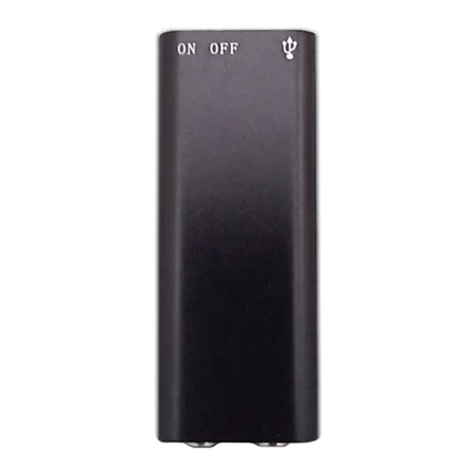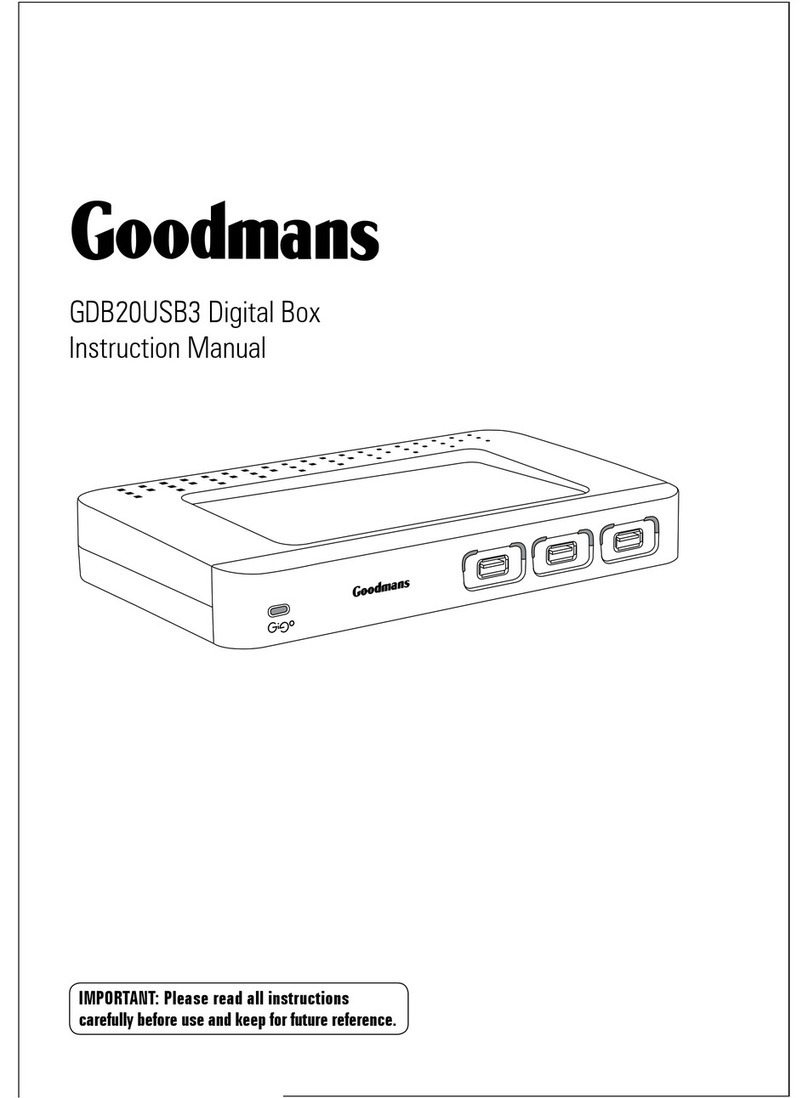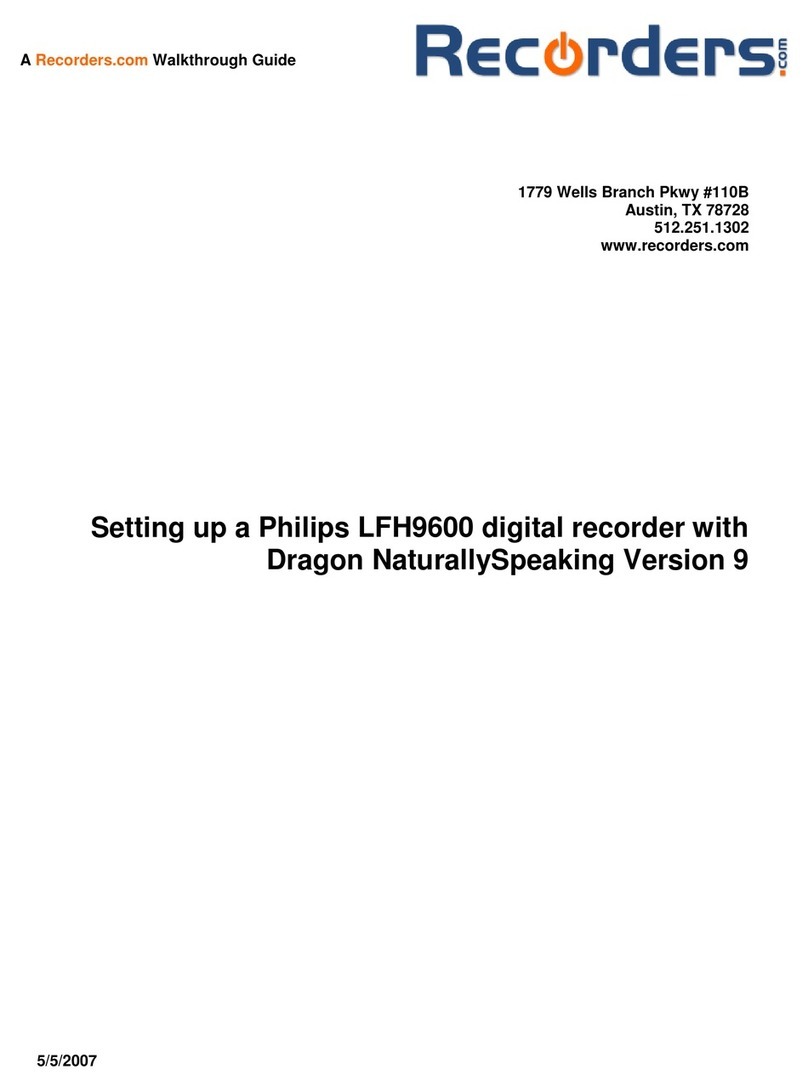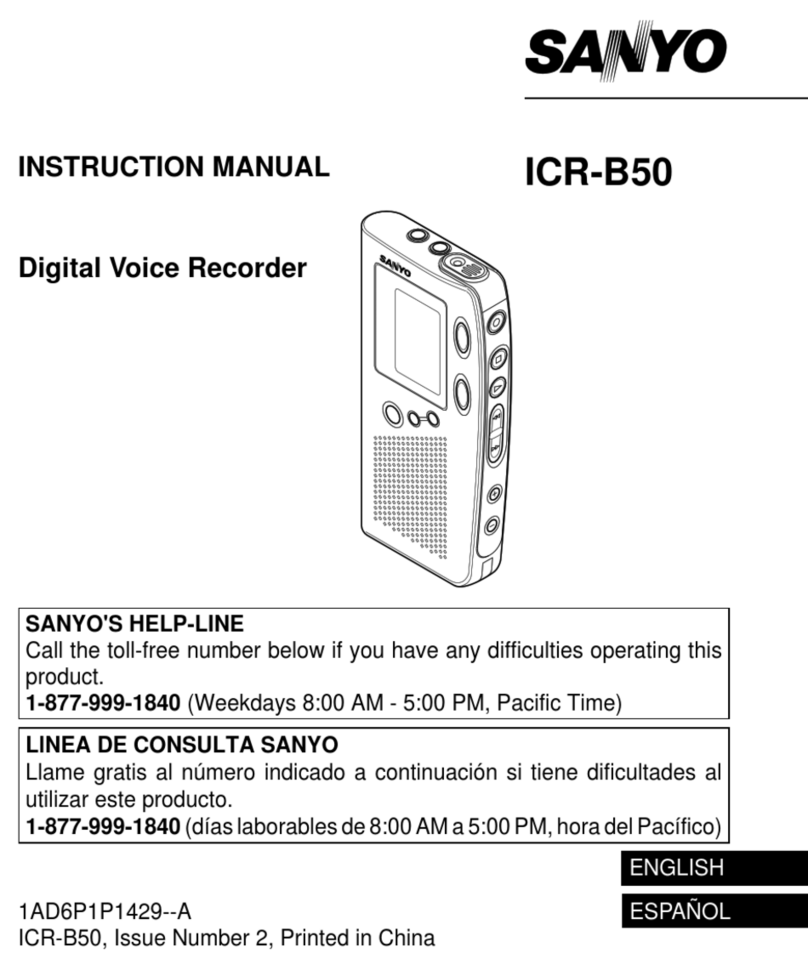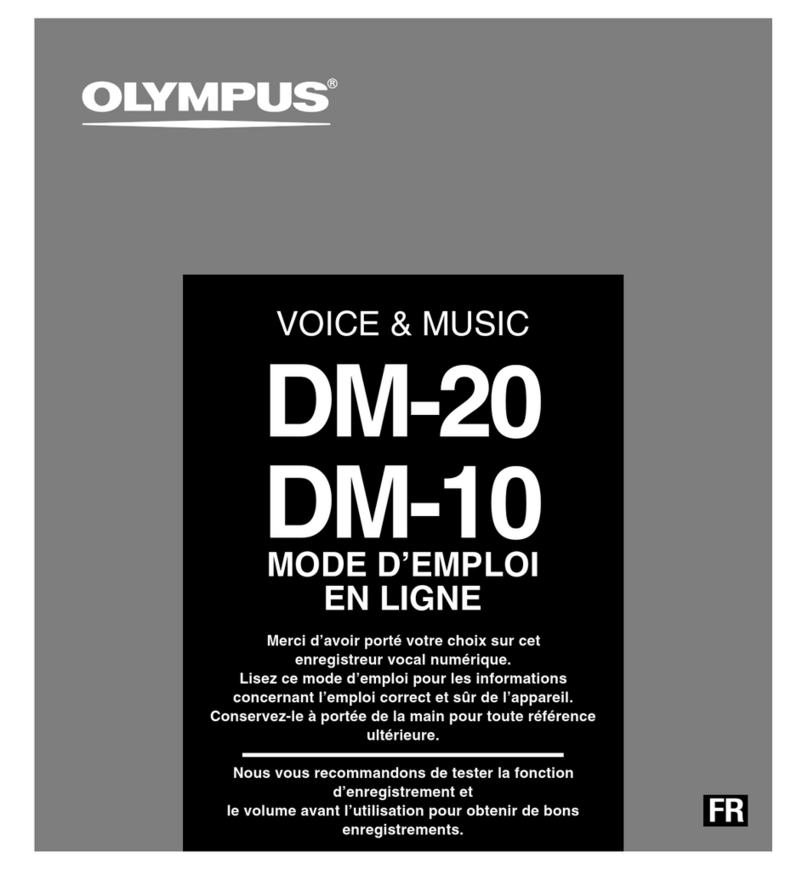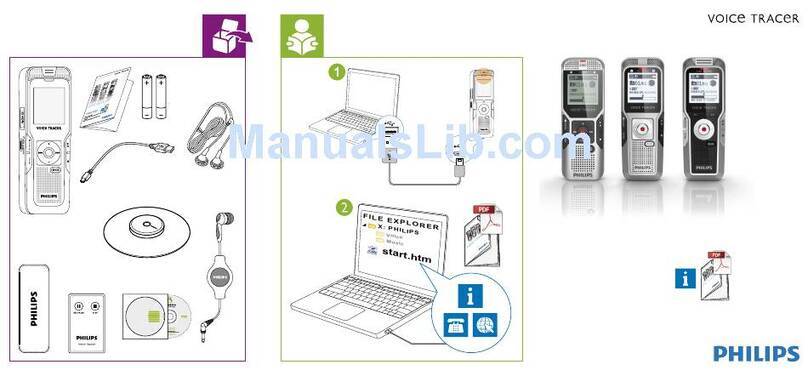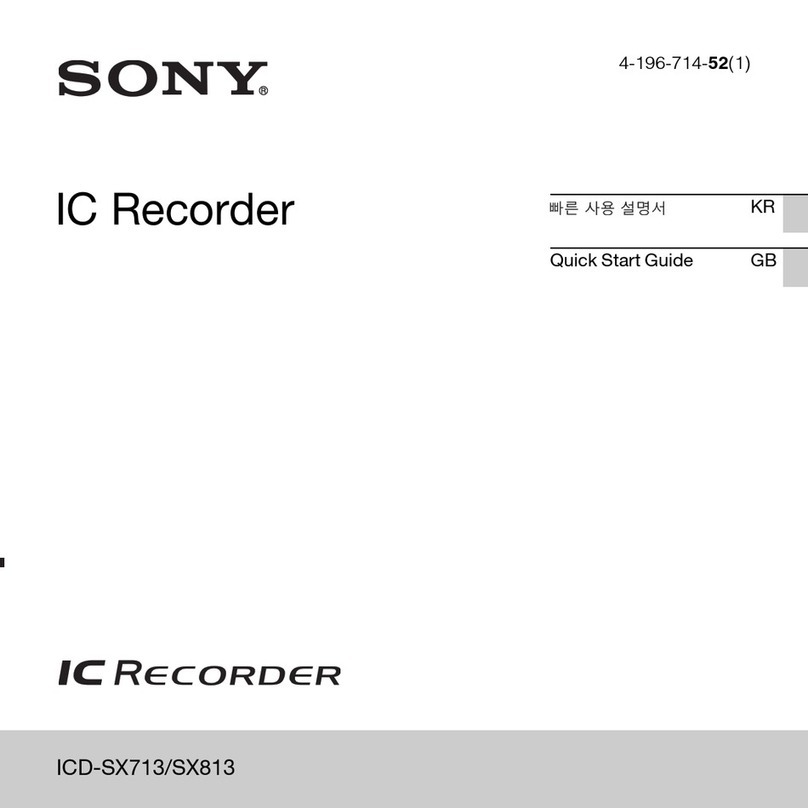Ekotape 212 User manual

PHoToFACT* FolJ"t EKOTAPE
MODET 2t2
JACK VOTUME
CONTROL
CONTROT -tINE
CORD
RECEPTACAL
CONTROL
KNOB
REMOTE
CONTROT
Figure 1
GENERAL INFORMATION
The Webster Electric Ekotape Recorder Model?LZ is for custom installation and has no
cabinet, orcarryingcase. TheModel2l2isdesignedto record and ptay back two tracks of mate-
rialonstandardwidthrecordingtape, which doubles the playing time of a standard 5'* or ?t'reel
of tapewithnolossoffrequency response or quality. Recording can be made from a radio, tele-
vision receiver or phonograph, in addition to those made directly from the microphone.
The Model 2t2 has two tape speeds, 3 3/4" and 7 112" per second. Using both tracks of
the taperrecording time is as follows:
MIKE
INPUT RECORD
tISTEN
CONTROT ON.OFF
swlTcr-l
SPEAKER
ON.OFF
SWITCH
J
ol
lll p
ce{
3-
5H
rg
Ex
H9
Fi
)o!
I lll
t\'
Size Reel
5tt
7"
3 3/4"Speed
t hour
2 hours
? 1/2"Speed
1/2 hour
t hour
Thisunitisdesignedto operate on 60 cycle, 115 volts, AC supply only. Before connecting
to your line supply, be absolutely certain that it agrees with the above specifications.
Manufactured by:
Webster Electric Company
Racine, Wisconsin
Fhis moteriol compiled ond published by
sAils & co., lNc., INDIANAPOLIS, INDIANA
Copyright 1915 . All Rights Reserved
DATE 12 - 55 $rT 301 TOTDER 1
HOWAR.D lf.

1e1;;;1r1e:1yi1+1.1;y1=;* ffi
. . :, : i:l;:i,::, .:::.I:::i:::a::i.i:::#
I
t;
r1 *{i?
$il
Figure 2
OPERATING INSTRUCTIONS
Preparing The Ekotape For Recording-
1. InserttheAC power cord into the receptacle
on the right side of the unit.
2. Plug t h e AC cord into a convenient wall re-
ceptacle of the proper rating.
3. Place a reel of tape on the left hand or "sup-
ply" spindle (9) in a manner so that the tape will un-
wind in a clockwise direction.
NOTE: The Ekotape isdesigned touse Type "A"wound
tape, i. e. the dull magnetic coated side faces
inward on the reel. If t h e tape used i s Type
"8" (coated side facing outward) the recording
will be made at a very low sound level and the
playback will be almost inaudible.
4. Place an empty reel on the right hand or
"take-up" spindle.
5. Unwind approximately 10" of tape and, while
holding a section of tape straight with both hands, in-
sert the tape in the tape slot making sure the dull
coated side of the tape faces the front of the recorder.
Page 2
6. Insert the free end of the tape through to the
hub of the "take-up" reel, f orcing it into one of the
three radial slots. While holding the tape in this po-
sition, turn the reel several turns (clockwise) until
the tape is secured to the r e e I and all slack is taken
up between reels.
To Make A Recording-
1. After the recording tape has been properiy
threaded, turn the "On-Off" control to the "On" po-
sition.
2. Turn the mechanism control knob (2) to "For-
ward".
3. Turn the "Record-Listen" selector knob to
the "Record" position.
NOTE: The "Record-Listen" selector knob will stay
in the "Record" position only when the mech-
anism control knob (2) is in the "Forward" po-
sition.
4. Turn the "Volume" control clockwise until the
incoming signal causes the "Record Indicator" to
flicker occasionally. A recording is now being made
on the tape.

To Record From Microphone-
1. Insert the microphone plug into the "Mic. "
jack, located on the left side of the top panel.
2. Followthe instructions under the heading of ,
"To Make A Recording",
3. Best results will be obtained if the micro-
phone is kept closer to the source of sound than to any
walls in the recording area to prevent echos of the
sounds as they rebound off the walls.
NOTE: The microphone should be kept at least three
feet away from the loudspeakerduringrecord-
ing unless the "Speaker " control knob is in "Off "
position.
To Record From Radio Or
Television Receiver-
Recordings can be made from a radio or tele-
vision receiver by placing the microphone near the lou&
speakerl however, this type of recording may not be
satisfactory as other sounds may be picked up by the
microphone which as a result may be recorded on the
tape. A superior quality recording can be made by use
of Radio Cord Attachment. Connect attachment cord
as follows:
1. Connect the cord clips across the voice coil
terminals on the radio or television speaker,
2. A terminal strip marked Rad-Pho- Input is
provided on the bottom of the chassis, and the other
end of cord should be connected here.
3. Set the radio or television receiver for soft
playing, then operate the Ekotapecontrols as
described under "To Make A Recording".
To Record From Phonograph-
1" Connect the alligator clips of the Radio Cord
Attachmenttotheendsof thepickup leads of the phono-
graph and then connect the other end to the terminal
marked Radio-Pho-Input. Proceed with the recording
as described under "To Make A Recording.'.
NOTE: Shoulda hum develope from the above connec-
tions, reverse the cord clips on the pickup
leads.
To Rewind-
Turn the mechanism control knob (2) counter-
clockwise into the "Rewind" position. When the re-
winding is completed move the mechanism control
knob (2)into"Stop" positionand allow the tapeto come
to a complete stop before moving the mechanism control
knob to any other function.
Twin Track Operation-
Model212 is a twin-track unit, whichrecordson
approximately half the width of tie tape at one time .
1. To record a secondprogram onthe same tape ,
lift the full reel from the right hand spindle,
turn it over, and place itonthelefthandspindle.
2. Place the empty reel on the right hand spindle ;
properly thread the tape, and continue your re-
cording as describedunder "To MakeARecord -
ing".
NOTE: Since it is impossible to edit and splice one
"track" without affecting the other, recordings
which are to be edited should be limited to one
track only.
To Play A Recording-
1. With the tape properly threaded, turn the
mechanism control knob (2) to the "Forward" position .
2. Actjust the "Volume" and "Tone" controls to
suit.
3. Besure thespeaker "On-Off" switch, located
on the right side of the top panel, is in the "On" po-
sition.
Fast Forward-
If it is desired to reach a recording near the
endof atape ina few seconds, turn rrreehanismcontrol
knob (2) to the "Fast Forward" position. In the "Fast
Forward" position the tape moves ahead approximately
15 times normallistening speedof 3 3/4 or 7 L/2inches
per second. The most rapid fast f orward speed is
therefore obtained with the speed control set at 7 L/2 .
REMOVING UNIT FROM MOUNTING BOARD
All service work with the exception of cleaning
the head assembly, adjustment or replacement of brake
lever assemblies (45 and 54), remote lever assembly
(51), pinch roller and lever assemblies (22), (23) and
(18), pressure padassembly (28), will require removal
of unit from the mounting board.
1. To remove the back cover (5) for cleaning of
the head remove all control knobs, and remove two
screws located under mechanism control knob (2). Move
back cover (5) about 1/16 inch toward the front of the
unit and lift straight up and off.
2. Toremove recordhead cover (?), remove one
attaching screw and li-ft off.
3. For removal of the top panel assembly (13),
followtheabove instructionsand remove seven screws
on panel and two under back cover (5). Lift panel
straight up and off.
4. To remove recorder from mounting board,
omitparagraph 1, 2and 3, detachtheAC line cord, re-
movetwoscrewslocatedon each side of the top panel.
Carefully lift unit straight up and out, detaching all
leads, and other connections to the amplifier . Make
sure unit is completely free of the amplifier,
5. When reassemblingthe unit, reverse the above
procedurel plug the amplifier leads into the unit as
marked on the bottom of the unit. Be sure that all leads
clear all moving parts before lowering into place.
6x
H9
F>
Nr!
rm
19
Page 3

Fig.ure 3
TRoUBLES AND REMEDIES 3. Arr,plifier troubte.
Motor Or Amplifier Inoperafive When On-Off Control
Switch Is Turned On- 4. Worn or dirty pressure pad, See "Pressure
Pad And Lever Adjustments".
1' check to see if power is reaching recorder' b. pressure pad spring (2g) roose or missing.
2.Damaged power cord. (a) The pressure pad lever assembly (28)
@Repair or replace. should apply pressure against the tape, thus
holding the tape f i r m against the recording
3. Damaged "On-Off" control switch. head. If this is not true, check the pressure
@Replace "On-Off" control switch assembly. padspring (29); if looseor missing, replace.
4.Defectivepowertransformer, orrectifiertubg Erasing Incomplete Or No Erase-
will cause the amplifier to be inoperative.
@Replac"po*e"transformer. or rectifier tube. 1. Dirt on face of play-record head.
(a) Clean with soft cloth and carbon tetrachlo-
Sound Is Fuzzy, Faint, Distorted, ride.
or No sound- z. oscillatorcoilassemblyortubenotoperating.
1. Dirty head. (a) Check erase voltage with an AC vacuum
(a) Check the record head (30) to see if it is tube voltmeter. There should be a reading
dirty. The recording head is subject to an of approximately 45 volts.
accumulation of tape coating residue, which
is worn off the tape as it passes the head. 3. Defective erase coil in head.
This should be periodically removed since it (a) Check erase head continuity.
may cause faint recordings and poor playback .
Wipe off the record and erase head contact 4. Pressurepadsworn ornot properlyadjusted.
surfaces carefully with a clean cloth. If dirt See "Pressure Pad And Lever Adjustments".
is caked or hard and will not come off with a
dry cloth, dampen the cloth slightly with Failure To Record-
carbon tetrachloride. 1. Record coil open.
NOTE: Do not use a brush or excessive amount of (a) Replace play-record head (30).
solvent on the head surfaces. 2. Insufficient bias voltage.
2. Over recorded or under recorded tape. (a) Check bias voltage across play-record
(a) Correctrecording volume is very impor- head w ith an AC vacuum tube voltmeter.
tant. Too weaka signal, whichdoesnotcause There should be a reading of approximately
the recordlevel indicator to flicker, will re- 100 volts.
sult in weak playback and high background
noise. Too strong a signal, causing the in- 3. Dirt on face of play-record head.
dicator to g I o w continuously, will result in (a) Clean with soft cloth and carbon tetrachlo-
distortion during playback. ride.
Page 4

I
4.
adjusted.
WiIl Not
Figure
Pressurepad worn, defective ornot properly
(a) Adjust pressure pador replace. See
"Pressure Pad And Lever Adjustments".
PIay Back-
4(a) Replace or readjust. See "Adjusting
Brake Lever Assembly".
Take-Up Or Fast Forward Inoperative,
1. Iake-up clutch worn or out of adjustment.
(a) Adjust or replace. See "CorrectingTake-
Up And Fast-Forward Troubles".
2. Drive pin (67) missing.
(a) Replace.
3. Brakes dragging on supply reel.
(a)Adjust brakes. See "Adjusting Brake
Lever Assembly".
4. Take-upreel supportplate (62) dirtyor dam-
aged, (a) Clean, Iubricate or replace. S e e "Cor-
recting Take-Up And Fast-Forward Trou-
bles",
5. Noisy, take-up or fast forward.
(a) Clean, Iubricate or replace.
6. Defective idler wtreels (?6 or 86).
(a) Replace. See "Correcting Take-Up And
Fast-Forward Troubles". (Paragraph 4).
?.. Reel take-up support plate spring (61) broken.
(a) Replace.
Tape Overruns From Fast Forward
To Forward Position-
1. Supply reel brakes not functioning properly,
worn or out of adjustment.
(a) Replace or readjust. See "Adjusting
Brake Lever Assembly".
2. Pinch roller (18) damaged or out of adjust-
ment.
tx
H9
Fi
!H
1\'
1. Open coil in play-record head.
(a) Replace head.
2. Open input circuit.
(a) Check circuit.
Howl Or Ringing Sound-
1. Microphonic tube.
(a) Replace defective tube.
Trouble Common To Radio Receivers-
1. Defective cornponents.
(a) Check and replace in accordance with
standard practice.
Rewind Inoperative, Noisy Or lrregular-
1. Defective motor pulley assembly (94).
(a) Replace.
2. Supplyreel shaft supportassembly (55), dirty
or defective.
(a) Clean, Iubricate or replace.
3. Supply reel support spring (60) is broken.
(a) Replace.
4. Brake (45) dragging on take-up reel.
(a) Adjust brakes. See "Adjusting Brake
Lever Assembly".
Tape Overruns From Rewind To Stop-
1. Take-up reel brakes (45) not functioning pro-
perly, worn or improperly adjusted.
Page 5

dl I
I
I
A PHOTOFACT 'EXPLODED" VIEW
@ Howard W. Sams & Co., lnc. 1955
Page 6
Figure 5A. Exploded View Of Parts Above Baseplate.

-l
A PHOTOFACT "EXPLODED" VIE\(/
@ Howard W. Sams & Co., lnc. 1955
Figure 58 , E>rploded View Of Parts Below Baseplate.
Ex
H9
Ft
hr!
dm
N'
Page 7

Adjustment".
Noisy Running In Stop And
Forward Positions-
1. Defective idlers, dry bearings or flat spots
on idlers.(a) Clean, Iubricate or replace. See "Cor-
bles".
Tape Spills Out Of Supply Reel n-
1. Dirty or defective pinch roller (18).
(a) Clean, Iubricate or replace. See "Cor-
recting Take-Up And Fast-Forward Trou-
bles".
2. Pinchroller lever assemblies(22 and 23) out
of adjustment or damaged.
Page 8
Figure 6
(a) Repair or replace" See "Pinch Roller (a) Adjust or replace. See "Pinch Roller
Adjustment".
Mechanism Control Knob (2) Inoperative-
1. Loose set screw in knob.
(a) Tighten.
2. Loose set screws in pinch roller cam assem-
(a) Adjust and tighten.
Speed Selector Not Functioning-
1. Broken springs (74 and 75) on drive idler
assemblies.
(a) Replace.
Speed Equalization Switch Not Functioning-
1. Switch carn assembly (52) Ioose or broken.
(a) Tighten or replace.
recting Take-Up And Fast-Forward Trou- bty (35).

\t
I
6
o
ii !,';d
S .i lPo
E BTE
4 t66 .
9 -Loo
. c du
q 9 Hoo.5
g E d o!
J d E:? i;
EJPS'E"
3iislrH
( b E (,;g
- oo A!- D
:o!-9Fo
.acYa->a
5!". te_k
xt 3 EI Es
iEslaE.i
--i O Oi c U
:n6: E bs
PsEPEl9
6Eo".5oc
ABEIEgs
oc:iots
E-iou;+l
oo;-'"oo
&'SeE;i a
:;! J > c:
5t.Y9ri.9
,.., o ;: e ! L
E;885; g
.i ciai3d
F
EUJ
5:H
o.<U}
ro
sg
<r: {l
<
-@
()
t:(!l
td>
cr. U)
e
@tRE E
@
|o
o
-E@
@
@
8*
rq=
-l [*]t'
@
6tr
o>
v>
JHI''
@
F
t
o
|o
g.-a\
E/
@tE
@
e.
Ld
=
o
J
J
P
r
6
o
<) F
('
N
z
an
€
/i
E/
A.
=
o
G
o
c>
d
E
G
=t
<(J
k€
=e
=3
ko
Ee
6
a-N
=@
s|o
U
e-\
"-(5)
'-- I
ex
H9
Ft
}\'!
dm
N'
Page 9

2. Switch contacts worn, dirty or broken.
(a) Clean contacts or replace. See "Speed
Equalization Switch Adjustment".
Machine Inoperative When Mechanism
1. Damaged or worn cam and shaJt assembly
(35A). (a) Replace.
ADJUSTMENTS
Pressure Pad And Lever Adjustments-
Cleaning, adjusting or replacing pressure pad
assembly and lever assemblies should be done in the
following manner;
1. Toadjustpressurepadassembly(28), remove
back cover (5) and top panel (13). To remove
assembly f or cleaning, repair or adjustment,
remove spring (29) and retaining ring (27). Ro-
tate the pressurepad assemblyslightly counter-
clockwise and lift off. Reassemble in reverse
orderand lubricate (see "Lubrication"). Adjust
byturning cam and shaft assembly (35A) to "For-
ward" position and check to be sure pressure
pads engage groove of head properly.
NOTE: Be sure flat of pad presses against the erase
and record p o I e pieces. To adjust properly ,
bend levers accordingly.
Improper Rewind Operation-
Ifthe unit doesnot perform therewind operation
properly, check as follows:
1. Adefective motorpulley(94) maybe the cause
of improper rewind. To replace a defective
motor pulleyassembly, remove the three mount-
ingscrews (103) from motor and plateassembly
(104). Carefully remove theassembly so as not
to damage the drive idler assemblies (?6 and 86).
Before removing the motor pulley measure and
note distance from hub to motor. Loosen the
twoAllen head set screws andremove themotor
pulley assembly, Reassemble with a new pulley
inreverse order, Be surepulley hub is correct
distance from motor as previously noted.
2. Adirty or defective supply reelshaft support
assembly (55) may be responsible for improper
rewind. To correctfaulty operation, clean, re-
pair or replace any damaged or worn parts.
Adjusting Brake Lever Assembly (45 and 54)-
If tape overruns from "Rewind" to "Stop" posi-
tion, adjust, clean or replace brake lever assembly
(45).
1. To ad just brake lever assembly (45), turn
camand shaft assembly (35A) to"Rewind" posi-
tion. Adjust either by bending the brake lever
assembly (45) or by slightly bending the stop on
mechanism panel just enough to clear the cup
disc on reel shaft (10). Clearance should not
exceed 1/64 inch. Adjust brake lever (45) so
that remote Iever (51) returns to "Stop" posi-
tion. Check to be sure brake lever (54) on the
supply reel (9) is being held in its stop position
Page 10
by the remote lever assembly (51). If not, turn
camand shaftassembly (35A) to "FastForward"
andadjust brake lever assembly(54) as outlined
above. Before reassembly of top panel, thread
recorder with tape and checkunit for any further
trouble.
2. If tape overruns from "Fast Forward" to
"Forward", check operation of brake lever (54)
as explained in above paragraph with this ex-
ception; turn cam and shaft assembly (35A) to
"Fast Forward" position and adjust brake lever
(54) on the supply reel (9). Check brake lever
(45) on the take-up reel to be sure it is held in
its stop position by the remote lever assembly
(51). f not, turn carn and sha"ft assembly (35A)
to "Rewind" and adjust brake lever as covered
in above paragraph.
Adjusting Brake Arm Assembly (113)-
If af ter completing adjustments as covered in
"Adjusting Brake Lever Assembly", the overrun on
"Rewind" and "Fast Forward" is not corrected, re-
move the unit from the case and check as follows:
1, Check "Rewind" position first and adjust or
replace brake arm assembly (113). First be
sure brake pad is still attached to arm. Turn
cam and shaft assembly (35A) to the "Rewind"
position and adjust the brake arm (113) so pad
just clears the reel pulley assembly (70) but by
no more than 1/64 inch.
2. Check "Fast Forward" position and adjust or
replace brake arm assembly (113). First be
sure brake pad is still attached to arm. Turn
cam and shaft assembly (35A) to "Fast For-
ward" position and ad just bral<e arm (113) so
thatthe pad clears reel pulley assembly (Ba) by
no more than 1/64 inch.
Correcting Take-Up And Fast
Forward Troubles-
If take-up and fast forward drive does not func-
tion properly, r e m o v e unit from case and check as
follows:
1. If the take-up or fast-forward drive is weak ,
screw the self-Iocking wing nut (?3) on the reel
shaft (10) s o spring (?2) will produce a greater
friction drive.
2. Ifafter adjustingthe self-locking wingnut
(?3) a weak drive still exists, then remove wing
nut, spring (?2), washer (?1) and reel pulley
assembly (?0) and check felt pad on pulley. If
pad is worn badly, replace assembly (70), but
if pad shows no excegsive wear, remove clutch
disc (68) and check to see i.f drive pin (6?) is in
place. Replace pin if missing and reassemble
in reverse order and adjust wing nut.
3. If unit i s noisy in "Forward" or "Fast-For-
ward" position, check to s e e if idler assembly
(110) isdirty or damaged, Or it may be the re-
sult of dirty bearings on the take-up shaft or
pulley assembly. To check, inspect idler
assembly (110) and determine if dirty or defec-
tive. Remove retainingring (112), fibre washer
(111), idler assembly (110), and fibr e washer
(111). Clean any dirt or oil from idler tire and

bearing. Clean flywheel and shaft assembly (89) ,
drive area only, also reel pulley(?0) drive area
witha suitable solvent, Relubricate idler bear-
ing and reassemble in reverse order.
4. If noise still exists in "Forward" or "Fast-
Forward"position check the reel shaft assembly
(10). Rem ove wing nut (?3) and spring (?2) ,
washer (71), reel pulley (?0), clutch disc (68),
pin (67), U-washer (66), washer (65), retaining
ring (64), fibre washer (63), reel pulley assem-
bty (10) and fibre washer (12). Clean and in-
spect all parts for wear or damage. Clean the
bearing in the reel support assembly (62) and
inspect bearing. Relubricate and replace any
defective parts and reassemble in order shown
on exploded view.
Pinch Roller Adjustment-
If pinch roller is damaged or out of adjustment,
clean and adjust in the following manner:
1. Toclean thefollower leverassembly (23) and
the pinch roller lever assembly (22), remove
springs (20 and 24), and retaining ring (21).
Remove both assemblies and shaf t attached to
mechanism plate. Clean thoroughly, removing
oldgrease and dirt, and relubricate. Reassem-
ble in reverse order. Adjust tab on follower
Leverassembly (23) so that pinchroller (22) en-
gages flywheel capstan just before lever (54)
releases supply reel pulley (9) from "Stop" po-
sition to "Forward". This prevents flare out of
thetape inthe supply reel, from "Stop"to "For-
ward" position.
MAINTENANCE
Cleaning The Play-Recor4 Head-
Theplay-recordhead is subject to anaccumula-
tion of tape coating residue which is worn off the tape
as it passes the head" This should beperiodically re-
moved since it may cause faint recordings and poor
playback. Wipe off the record and erase head contact
surfaces carefully with a clean cloth. If dirt is caked
orhard and willnot come off with a dry cloth, dampen
the cloth slightly with carbon tetrachloride.
NOTE: Donot use abrush or exeessiveamount of sol-
vent on the head surfaces,
Lubrication-
On normal use, the Ekotape requires a limited
amount of lubrication. Motor, flywheel shaf t, reel
spindles, pinch roller assembly and idlers operate in
oilite bearings. Whenever unit is disassembled for
repair, clean all bearings, cams, and levers, and
lubricate the following:
1. Lubricateall oilite bearings withSAE 20 oil .
2. Lubricate all cams and levers with Liqui-Moly
NV Grease or equivalent.
3. Appty a thin film of lubricant on the working
areas of parts.
NOTE: Do notuse cleaning solvent on oilite bearings.
Do not overlubricate, Ex
H9
Fi
}\t!
rl'l
19
EL AL PARTS LIST
Ref .
No. Part
No- Description Ref.
No. Part
No. Description
v1
v2
v3
V4
v5
v6
c1A
c1B
clc
c2A
c2B
c2c
c3
C4
c5
c6
c7
CB
c9
c10
c11
c12
c13
c14
c15
c16
c1?
24 1 - 19367
24L-t4238
s6063
s6065-3
s3595
s4261
s3595
2tt-r49t2
211 -30639
21 1 - 15048
s4261
s6065 -9
s6065-9
s6065-3
s6065-3
24t-L2t67-t
s6065-3
58?9, Pre. Amp.
6C4, 1st A. F. Amp.
6C4,2nd A. F. Amp.
6SN?GT, Record Amp. & Cathode
Follower
6AQ5, Bias Osc.
5Y3GT, Rectifier
Elect. Cap., 40MFD @450V.
Elect. Cap., 40MFD@450V.
Elect. Cap., 40MFD @)450V.
Elect. Cap., 40MFD@450V.
Elect. Cap., 40MFD@450V.
Elect. Cap., 40MFD@ 25V.
Elect. Cap., 50MFD@)OV.
Cap. Ceramic, 200MMF@ 500V.
Cap. Molded Paper, . 1MID@400V.
Cap. Molded Paper, . 05MFD
@400v.
Cap. Molded Paper,
Cap. Molded Paper,
200v.
Cap. Molded Paper,
400v.
Cap. Molded Paper,
400v.
Cap. Molded Paper,
400v.
.1MFD@4oov.
.05MrD@
.02MrD@)
.04?MTD@
.05MFD@
Cap. Ceramic, 400MMF @ 500V.
Cap. Ceramic, 400MMF@ 500V.
Cap. Ceramic, 200MMF @ 500V.
Cap. Ceramic, 200MMF@ 500V.
Cap. Molded Paper, . 006Mm@
400v.
Cap. Ceramic, 200MMF@ 500V.
c18
c19
c20
c2L
c22
c23
c24
R1
R2
R3
R4
R5
R6
R?
R8
R9
R10
Rl1
R12
R13
R14
R15
R16
R1?
R18
R19
R20
R21
F"22
R23
P"24
R25
R26
s6065-3
zlt-t4492
211-18931
24L-14260-l
24L-t4260-t
s6065 -2
241-L4260-2
24L-L7940
29501 -53
29501 -29
29501 - 1 1
29501 -53
29501 -56
29501 -44
29501 -35
29501 -14
29501 -35
2950r-44
29501 -41
29501 -14
29501 -48
29501 -21
29501 -56
29501 -?5
29501 -35
29501 -95
29501-44
29501 -53
29501 -48
29501 -48
29501 -41
29501 -32
29501 -36
Cap. Ceramic, 200MMF@ 500V.
Cap. Molded Paper, . 2MFD@400V.
Cap. Molded Paper, .47MFD@)
200v.
Cap. Ceramic, 3000MMF@ 500V.
Cap. Ceramic, 3000MMF@ 500V.
Cap. Ceramic, 100MMF@ 500V.
Cap. Ceramic, 1?000MMF@ 500V.
Volume Control,500K, 1/2 W.
Resistor, 510K, 1/2 W.
Resistor, 22K, L/2 W.
Resistor, lK,L/2 W.
Resistor, 5t0K,l/2 W.
Resistor, 1MEG, l/2 W.
Resistor, 150K, 1/2 W.
Resistor, llK, L/2 W .
Resistor, 2K, t/2 W .
Resistor, ltK,l/2 W.
Resistor, llOK,l/2 W.
Resistor, 100K, 1/2 W.
Resistor, 2K, L/2 W .
Resistor, 240K,t/2 W.
Resistor, 5.lK,l/2 W.
Resistor, 1MEG, L/2 W.
Resistor, S. 1K, 1 W.
Resistor, llK,L/2 W.
Resistor, 2MEG, l/2 W.
Resistor, 150K, 1/2 W.
Resistor, 5L0K,l/2 W.
Resistor, 240K,L/2 W.
Resistor, 240K,I/2 W.
Resistor, 100K, 1/2 W.
Resistor, 30K, 1/2 W.
Resistor, 62K,1/2 W.
Page 11

P- uon
r('EI
No. Part
No. Descrintion Ref .
No. Part
No. Description
P-27
R28
R29
R30
R31
R32
R33
R34
R35
z9DUr -:to
29501 -14
29501 -35
29501 -53
29501 -29
29501 -53
29501 -17
29501 -41
29502-15
tteslstor, OZf\, L/Z W.
Resistor, 2K,L/2 W.
Resistor, llK,l/2 W.
Resistor, 510K, 1/2 W.
Resistor, 22K,1/2 W.
Resistor, 510K, 1/2 W.
Resistor, 3K,l/2 W.
Resistor, 10K, L/2 W.
Resistor, 1K,5W.
rtJU
T1
L1
L2
M1
M2
M3
M4
M5
MA
242-t1935
241-14246-l
242-L1937
28755-7
P1 1139-1
242-LBl65
241-r7949
24t-t7942
29502-14Resistor,20K, 10W,
Power Transformer
Bias Osc. Coil
Filter Choke
Fuse,2Amp.
Lamp, #51
Selector Switch Assy.
Equalizer Switch
Speaker Switch
ELECTRICAL PARTS LIST - Con'
No.
ttel Part
No. Description tiel.
No. yarL
No, Description
1
21
3
4
5
6
7
I
I
10
11
t2
13
t4
15
16
t7
18
19
20
2l
22
23
24
25
26
27
28
29
30
31
32
33
34
35
35A
36
3?
38
39
40
4l
42
43
44
45
46
47
48
49
50
51
52
53
54
55
56
57
24L-t78t8-l
242-19844-r
241-15116
242-L78L5-l
24t-t7816-2
29529-t4
24t-t78r7 -L
29529-4L
242-t776t
242-1777t-L
24L-L7770
24L-L7770
24t-r7814-l
29529-40
29527 -4
29602-103
24t-t'1747
242-17744
24L-L7722
241 - 12138
29650- 1
242-t774r-2
242-L',t739-2
24L-17734
29650- 1
242-r7748-l
24t-t7801
242-L4r59
29527 -13
24t-t7154
241,17753
24t-L7152
242-t77tO-l
242-t7707 -l
242-t77t3-L
24 1 - 1?801
29651-1
241 -12059
29602-t24
241-L7134
242-L7683-3
29651 -1
244-L1758-t
24t-t7734
24t-12059
29602-L22
29651-1
24t-r7734
242-17755-L
242-t9345
242-t775
242-t7758-l
242-17695-l
29602-L24
24t-t2059
Control Knobs, Amplifier
Mechanism Control Knob Assy,
Socket Hd. Set Screw
Knob Assembly
Back Cover
Rec. Pan. Hd. Mach. Screw
Record Head Cover
Rec. Pan Hd. Mach. Screw
Reel Shaft Assembly (left)
Reel Shaft Assembly (right)
Washer, Fibre
Washer, Fibre
Top Panel
Mach"Screws Top Panel Mtg.
Screw
Washer, Steel
Washer, Fibre
Pinch Roller Assembly
Washer, Fibre
Spring
Retaining Ring
Pinch Roller Lever Assembly
Follower Lever Assembly
Spring
Screw, Record Head Mounting
Flat Washer Steel
Retaining Ring
Pressure Pad Assembly
Spring
Play-Record-Erase Head Assy.
Screw (2 Used)
Top Tape Guide (2 Used)
Tape Guide Spacer (2 Used)
Tape Guide Shelf
Pinch Roller Cam Assembly
Cam and Shaft Assembly
Index and Interlock Lever Assy.
Spring
Retaining Ring
Spring Tension Washer
Washer
Remote Lever Arm
Spring
Mechanism Plate Assembly
Retaining Ring
Brake Lever Assembly
Spring
Spring Tension Washer
Washer
Retaining Ring
Spring
Remote Lever Assembly
Switch Cam Assembly
Set Serew
Brake Lever Assembly
Reel Shaft Support Assy.
Washer
Spring Tension Washer
58 I
seI
60 I
61 I
62 I
63 1
64 1
65
66
67
68
69
?0
7l
12
73
74
75
76
77
?B
79
80
81
82
83
84
85
B6
8?
BB
89
90
91
92
93
94
95
96
9?
98
99
100
101
102
103
104
104A
105
106
10?
108
109
110
111
tt2
11?
24r-t7770
24t-L7770
241-1?801
241 -1?801
242-r7103-2
24t-t7770
29650-2
29602- 133
24L-r7775
24L-t7086-4
24t-17771
29650-2
242-r7773-t
29602 - 102
241-tI644
24L-21799-l
24r-r1802
241-t7802
242-L7136-r
29650-1
24t-t7723
242-t7724-1
242-r7739-2
24L-L77L7 -t
24L-t77L7 -L
242-r7737 -2
242-L7766-l
242-1773t-2
24L-t7723
29650-1
241-r7718-r
24r-13609
29650-1
24t-17723
242-t77BB-2
241-t7789-2
242-t7765-r
241-t7674
24L-t7786-r
24L-14t34
242-t77t6-l
24t-17723
29650-1
242-I77L9-3
241-17122
29650- 1
tat _11eea
Washer, Fibre
Washer, Fibre
Spring
Spring
Reel Shaft Support Assy.(right)
Washer, Fibre
Retaining Ring
Washer, Steel
U-Washer, Steel
Pin
Clutch Disc
Retaining Ring
Reel Pulley Assembly
Washer, Steel
Spring
Self Locking Wing Nut
Spring
Spring
Top Lever and Idler Assy,
Retaining Ring
Spring Tension Washer
Cam Shaft Assy.
Follower Lever Assembly
Idler Link Assembly
Idler Link Assembly
Follower Lever Assembly
Reel Pulley Assembly
Set Screw Allen
Lower Lever and IdlerAssy.
Spring Tension Washer
Retaining Ring
Flvwheel and Shaft Assy.
Steel Ball
Retaining Ring
Keyed Washer
Spring Tension Washer
Motor Pulley Assembly(Includes
items 95, 96 and 9?)
Motor Pulley Clutch Washer
Motor Pulley
Allen Set Screw
Lockwasher
Support Plate Mounting Screw
Support Plate Assembly
Washer Steel
Lockwasher
Motor Mounting Screw
Motor
Motor Mounting Plate
Fan
Set Screw
Idler Link Assembly
Spring Tension Washer
Retaining Ring
Idler Assembly
Washer Fibre
Retaining Ring
Brake Arm Assemblv
Page 12
Table of contents
Popular Voice Recorder manuals by other brands
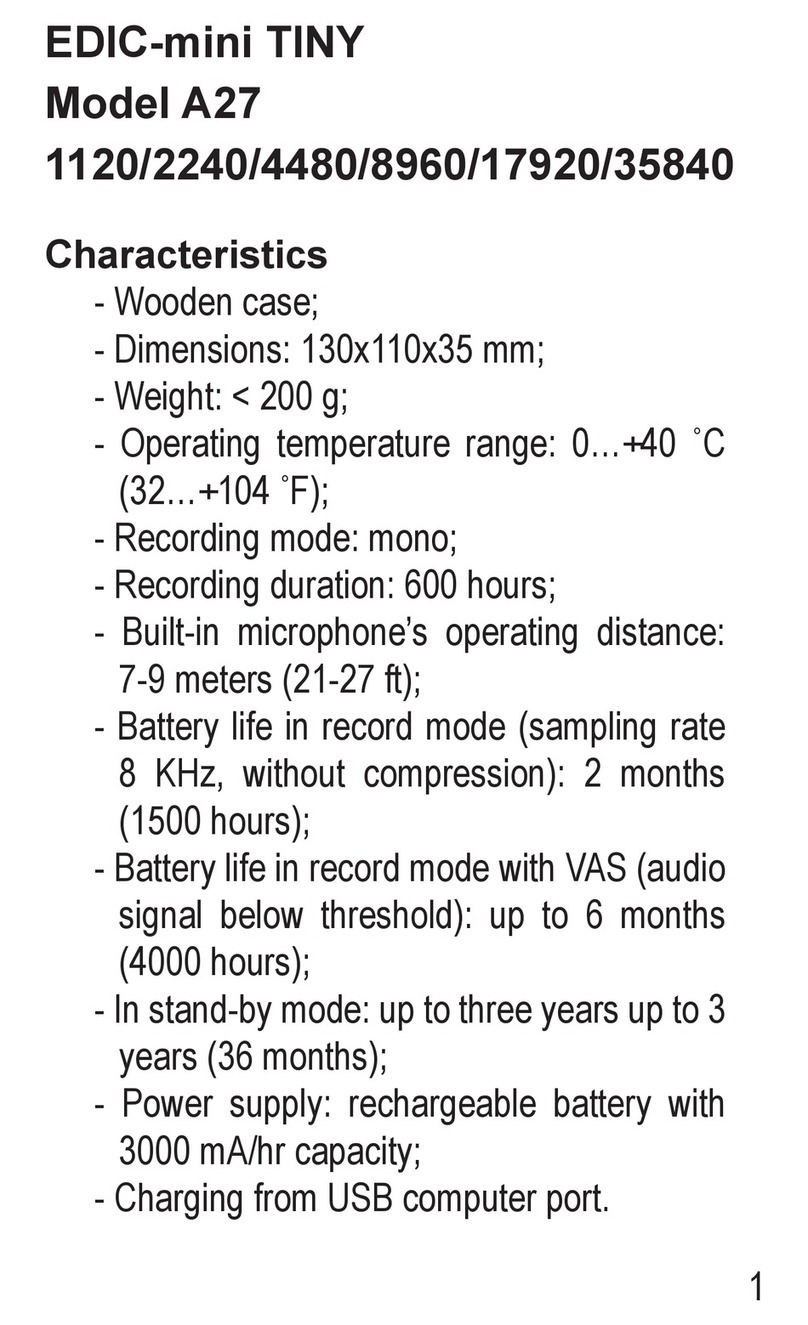
EDIC-mini
EDIC-mini TINY A27 1120 Short operating instructions
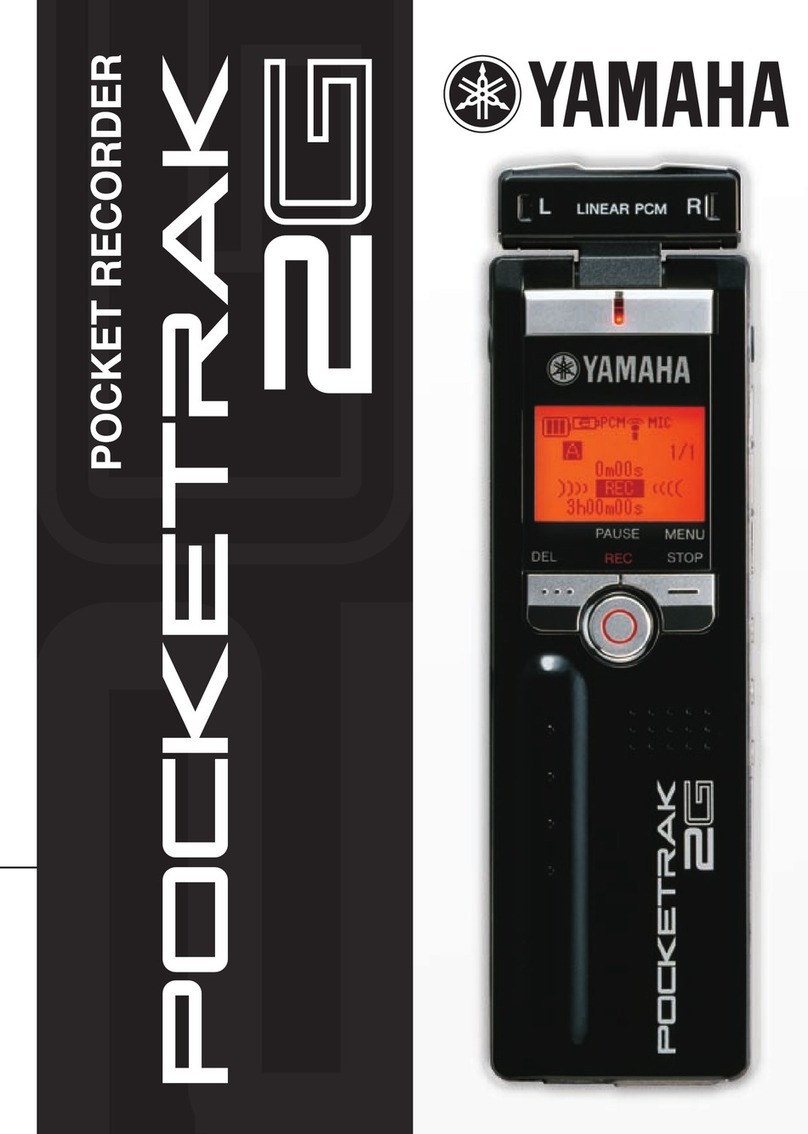
Yamaha
Yamaha POCKETRAK 2G - 2 GB Digital Player Brochure & specs
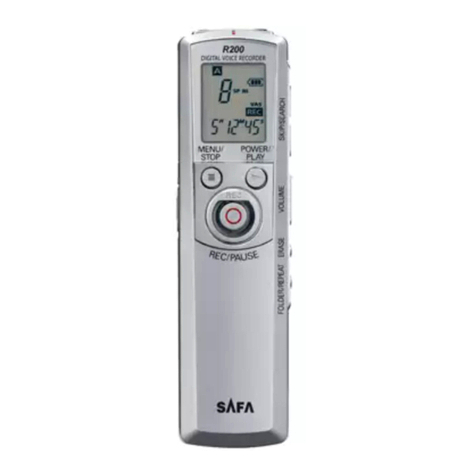
Safa Media
Safa Media R200 instruction manual
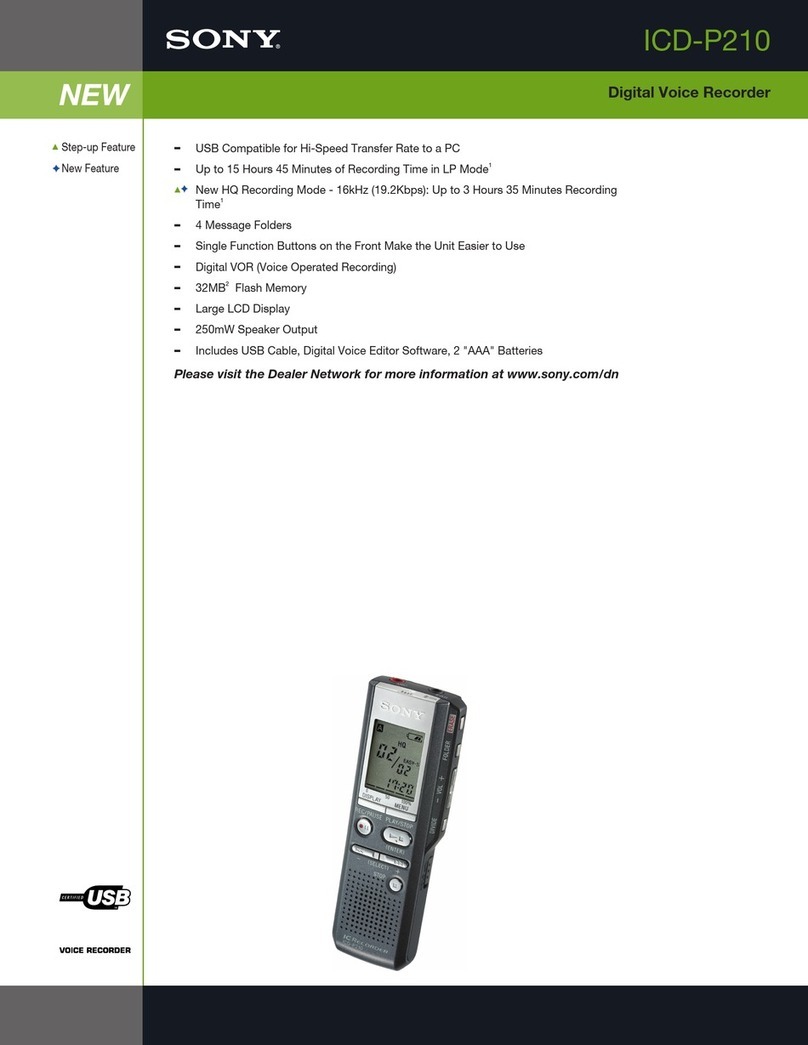
Sony
Sony ICD-P210 Digital Voice Editor 2 Specifications

Sony
Sony ICD-UX300 - Digital Flash Voice Recorder Specifications
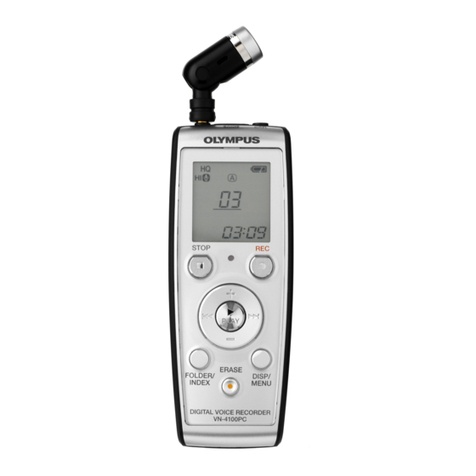
Olympus
Olympus VN 4100 - 256 MB Digital Voice Recorder instructions
